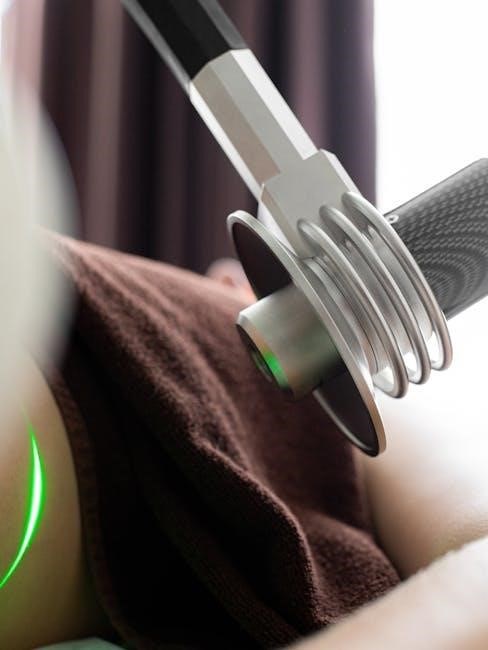Face piercings are a vibrant form of self-expression, offering a way to enhance personal style and individuality. With various types like nostril, septum, and lip piercings, they allow individuals to explore unique aesthetics while considering factors like aftercare and pierced anatomy.
1.1 What Are Face Piercings?
Face piercings are decorative perforations in facial tissue, such as the nose, lips, eyebrows, or cheeks, enhanced with jewelry. They serve as a form of self-expression and personal style, allowing individuals to showcase unique aesthetics through various piercing types and designs.
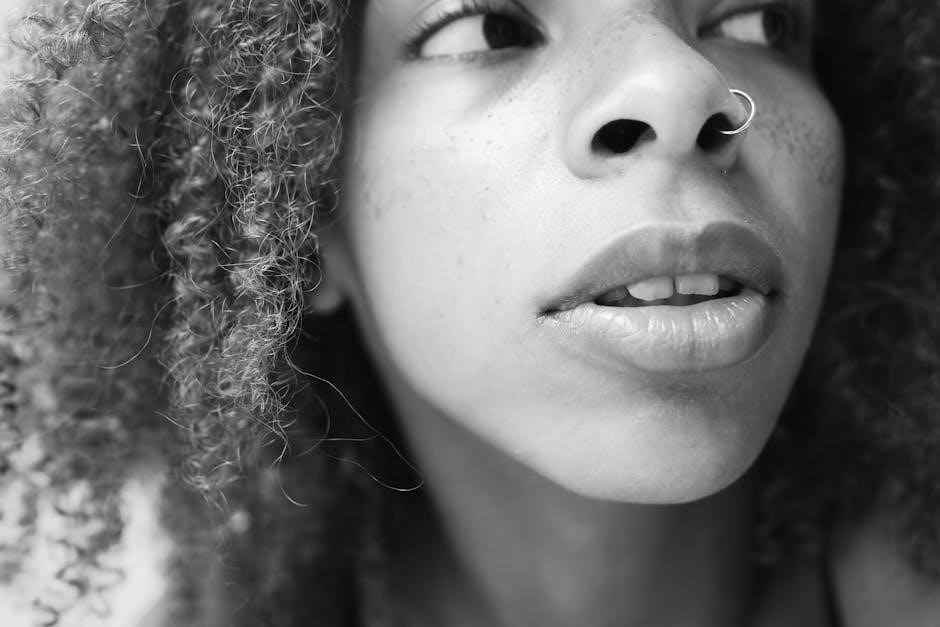
1.2 Popularity and Trends in Facial Piercings
Facial piercings have grown in popularity, becoming a mainstream form of self-expression. Trends include minimalist designs, delicate jewelry, and strategic placements like septum and high nostril piercings. Celebrities and social media influencers have further fueled their appeal, making facial piercings a staple in modern fashion. Current trends emphasize individuality, with many opting for bold or subtle styles to enhance their unique features and personal aesthetics.
1.3 Benefits and Risks of Facial Piercings
Facial piercings offer a creative outlet for self-expression and confidence. However, they carry risks like infections, allergic reactions, and scarring. Proper aftercare is crucial to minimize complications. While piercings can enhance one’s aesthetic, understanding the potential risks ensures informed decisions, balancing the benefits of personal style with responsible care and maintenance for long-term satisfaction and safety.

Popular Types of Facial Piercings
Facial piercings include options like nostril, septum, eyebrow, and lip piercings, each offering unique styles to suit individual preferences and enhance personal features while adding charisma to one’s appearance.
2.1 Nostril Piercings
Nostril piercings are a popular choice, known for their elegance and versatility. They involve piercing the soft tissue of the nostril and can be adorned with studs, hoops, or rings. Healing typically takes 2-3 months, with proper aftercare essential to prevent infections. This piercing complements various face shapes and is a timeless addition to personal style, offering subtle yet striking appeal.
2.2 Septum Piercings
Septum piercings involve piercing the thin membrane separating the nostrils. This versatile piercing is popular for its edgy appeal and can be styled with rings, hoops, or clickers. Healing typically takes 6-8 weeks, with proper aftercare crucial for comfort. Its central location makes it a striking addition to various facial aesthetics, offering a bold yet elegant look for those seeking self-expression.
2.3 Eyebrow Piercings
Eyebrow piercings are a bold, eye-catching choice, typically placed horizontally above the brow. They can be adorned with studs, rings, or curved barbells. Healing requires 6-8 weeks, with aftercare essential to avoid complications. This piercing complements various face shapes and styles, offering a striking, modern aesthetic for those looking to make a confident fashion statement with their appearance.
2.4 Lip Piercings (Labret, Snake Bites, etc.)
Lip piercings, such as Labret and Snake Bites, are popular for their edgy appeal. Labret piercings are centered below the lip, while Snake Bites involve two piercings on either side. These styles highlight facial symmetry and allow for creative jewelry choices like studs or rings, making them a versatile option for those seeking a unique, expressive look with minimal maintenance.
2.5 Bridge Piercings
Bridge piercings are placed on the bridge of the nose, offering a striking, edgy aesthetic. They are popular for their unique appeal and versatility in complementing various face shapes. Proper aftercare is essential to avoid complications, and professional guidance is recommended for optimal placement and safety, ensuring a smooth healing process and a bold, standout look.

The Piercing Process
The piercing process involves preparation, a precise procedure, and selecting suitable jewelry. It’s a detailed process requiring care and attention to ensure safety and optimal results.
3.1 Preparation for Getting a Face Piercing
Preparation is key to a smooth piercing experience. Research reputable piercers, understand the procedure, and learn aftercare basics. Eat beforehand, maintain good skincare, and avoid alcohol or caffeine. Choose jewelry suited to your piercing type and ensure you’re mentally prepared for the process.
3.2 The Piercing Procedure
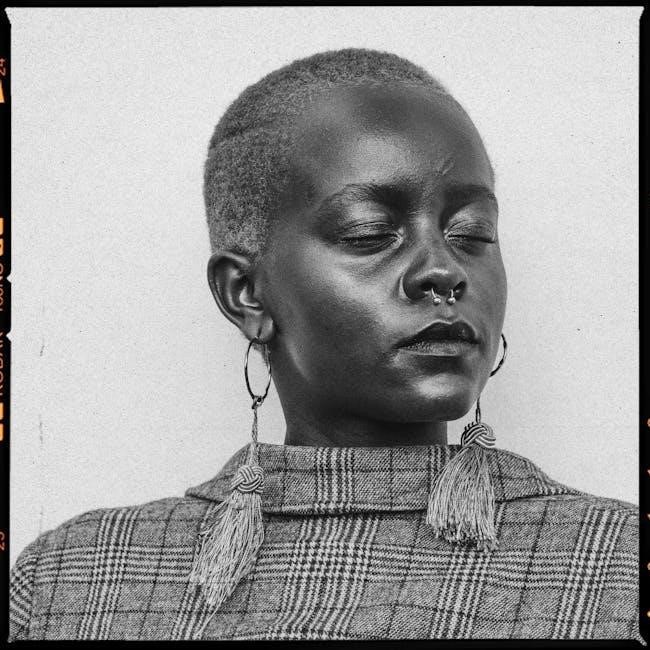
The piercing process begins with marking the area for accuracy. A sterile needle is used to create the piercing, followed by jewelry insertion. Professional piercers ensure a clean, safe environment, minimizing discomfort. Aftercare instructions are provided to promote healing and prevent complications, ensuring a successful outcome for your facial piercing.
3.3 Choosing the Right Jewelry
Selecting the right jewelry is crucial for both aesthetics and comfort. Popular options include studs, hoops, and labrets, made from materials like surgical stainless steel, titanium, or gold. Jewelry should complement the piercing location and personal style while ensuring proper fit and safety. Consulting a professional helps determine the best jewelry for your specific piercing, ensuring optimal healing and satisfaction.

Healing and Aftercare
Proper aftercare ensures smooth healing and minimizes complications. Clean piercings with saline solution, avoid tight clothing, and maintain hygiene. Healing times vary by piercing type, and professional touch-ups may be needed for optimal results.
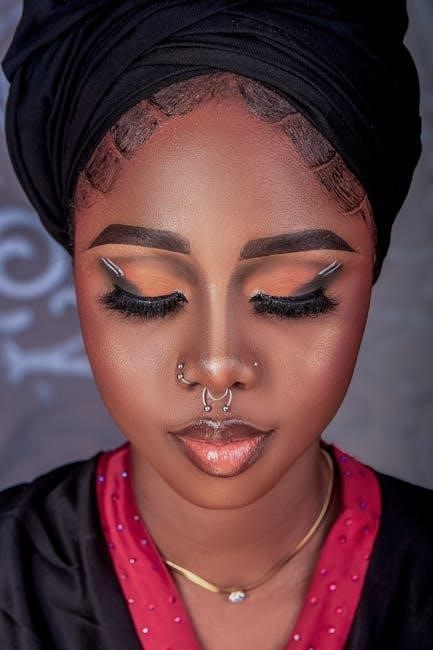
4.1 Healing Times for Different Facial Piercings
Healing times vary by piercing type. Nostrils typically heal in 2-4 months, while septum piercings may take 3-6 months. Eyebrow piercings often heal within 6-8 weeks, and lip piercings usually take 1-3 months. Proper aftercare and jewelry quality significantly impact healing duration. Consistency in cleaning and avoiding irritants ensures faster recovery and reduces the risk of complications.
4.2 Aftercare Tips for Facial Piercings
Proper aftercare is crucial for healing. Rinse the piercing with saline solution daily, avoiding harsh chemicals like hydrogen peroxide. Gently clean with mild soap and water. Avoid touching or rotating jewelry excessively, as this can irritate the area. Keep the piercing dry and avoid submerging it in water until fully healed. Consistency ensures a smooth recovery.
4.3 Common Mistakes to Avoid During Healing
Avoid over-cleaning, as it can delay healing. Refrain from touching the piercing excessively, as this introduces bacteria. Do not rotate jewelry unnecessarily, which can cause irritation. Avoid using harsh chemicals like hydrogen peroxide, which can damage tissue. Do not submerge the piercing in water, such as in pools or hot tubs, until fully healed. These mistakes can lead to complications.
Potential Risks and Complications
Face piercings carry risks like infections, allergic reactions, and scarring. Improper aftercare or low-quality jewelry can lead to complications, emphasizing the importance of proper hygiene and professional guidance.
5.1 Infections and How to Prevent Them
Infections are a common risk with face piercings if proper aftercare isn’t followed. Using saline solutions for cleaning and avoiding tight clothing can help prevent bacteria buildup. Keeping the area moisturized and avoiding touching the piercing reduces infection chances. Early signs of infection, such as redness or swelling, should be addressed promptly to avoid complications.
5.2 Allergic Reactions to Jewelry
Allergic reactions to jewelry materials like nickel are common, causing irritation or rashes. Opting for hypoallergenic metals such as surgical stainless steel or titanium reduces risks. Symptoms include redness, itching, or swelling. Consulting a professional piercer to select suitable jewelry is crucial. In severe cases, switching to allergen-free options may be necessary to prevent prolonged discomfort or complications.
5.3 Scarring and Long-Term Effects
Facial piercings can lead to scarring or keloid formation if proper aftercare is neglected. Improper jewelry removal or prolonged healing issues may result in visible marks. While most scars fade over time, some remain permanent. Ensuring meticulous aftercare and avoiding excessive jewelry changes minimizes long-term effects, preserving your skin’s integrity and maintaining the piercing’s aesthetic appeal.
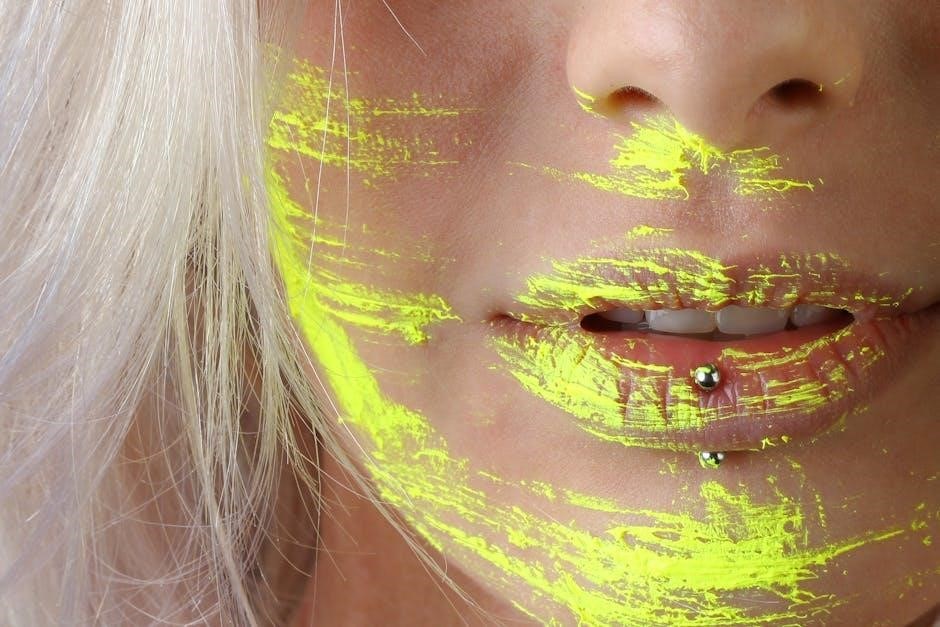
Hygiene and Maintenance
Proper hygiene is crucial for maintaining healthy facial piercings. Regular cleaning with saline solutions and avoiding harsh chemicals prevents infections. Consistent care ensures piercings heal smoothly and last longer.
6.1 Cleaning Solutions for Facial Piercings
Saline solutions are ideal for cleaning facial piercings, promoting healing and preventing infections. Mix 1/4 teaspoon of sea salt with 8 ounces of warm water for a gentle soak. Avoid harsh chemicals like hydrogen peroxide or alcohol, as they can irritate the skin. Regular cleaning ensures a smooth recovery and maintains the health of your piercing.
6.2 How to Maintain Proper Hygiene
Wash your hands thoroughly before touching your piercing. Avoid submerging it in water, such as in baths or pools, until fully healed. Gently clean the area with saline solution daily, and avoid tight clothing that may irritate the piercing. Keep jewelry clean and avoid touching the piercing unnecessarily to minimize the risk of contamination and infection.
6.3 When to Seek Professional Help
Seek professional help if you notice signs of infection, such as redness, swelling, or discharge, or if healing is delayed. Consult a piercer if jewelry becomes irritated or improperly placed. Additionally, if you experience severe pain or allergic reactions, professional advice is crucial to prevent complications and ensure proper care for your facial piercing.

Cost of Facial Piercings
Facial piercing costs vary by location and piercer expertise, ranging from $30 to $150 per piercing. Jewelry prices depend on material and design, adding to the total.
7.1 Average Prices for Different Piercings
Nostril piercings typically cost $30–$60, while septum piercings range from $50–$100. Eyebrow piercings average $40–$70, and lip piercings (like labret or snake bites) cost $40–$80. Bridge piercings are pricier, around $70–$120. Prices vary based on location, piercer experience, and jewelry quality, making it essential to research studios and compare rates before booking.
7.2 Factors Affecting the Cost
The cost of facial piercings varies based on location, piercer expertise, and jewelry quality. Studios in urban areas or with high reputations may charge more. Additionally, complex piercings or those requiring specialized techniques can increase prices. Jewelry material, such as gold or titanium, also impacts the total cost, as does the inclusion of aftercare products or consultation fees.
7.3 Budgeting for Jewelry and Aftercare
Budgeting for facial piercings should include both the initial cost and long-term expenses. Jewelry prices vary based on material and design, while aftercare products like saline solution add to the total. Plan for follow-up appointments and potential jewelry upgrades. Allocating extra funds ensures you can maintain proper hygiene and address any unexpected needs during the healing process.
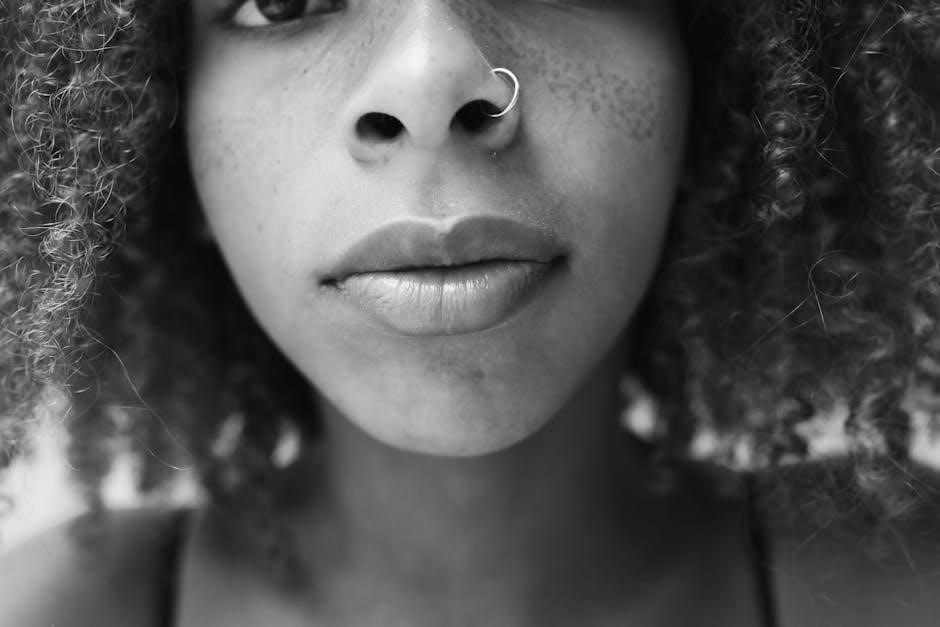
Facial Piercing Trends and Styling
Facial piercings are a fashion statement, with trends like minimalistic jewelry and multiple piercings gaining popularity. Styling options vary, allowing individuals to complement facial features and personal aesthetics.
8.1 Current Trends in Facial Piercings
Current trends in facial piercings emphasize minimalism and creativity, with delicate studs and dainty hoops gaining popularity. Multiple piercings, such as double nostrils and eyebrow stacks, are also on the rise. Bold statement pieces and unique placements like high nostrils and bridge piercings are favored for their edgy appeal. Personalized jewelry choices allow individuals to express their style uniquely.
8.2 Styling Tips for Different Face Shapes
Styling facial piercings to complement face shapes enhances their appeal. Oval faces can pull off most styles, while round faces benefit from elongated jewelry. Square faces look softer with curved designs, and heart-shaped faces can balance with lower piercings. Consider personal features and proportions to create a harmonious, flattering look that highlights individuality and beauty.
8.3 Jewelry Options for Unique Looks
Jewelry selection plays a key role in creating standout facial piercings. From minimalist studs to bold hoops, each piece offers a distinct aesthetic. Gemstones add elegance, while industrial designs provide an edgy vibe. Mixing metals like gold and silver can create a personalized look. The right jewelry elevates your piercing, making it a true expression of your style and identity.
Choosing a Reputable Piercer
Research and select a qualified piercer with extensive experience in facial piercings. Ensure they follow strict hygiene protocols and use high-quality equipment to guarantee safety and professionalism.
9.1 Qualifications and Experience
Ensure your piercer holds certifications from reputable organizations like the Association of Professional Piercers. Experienced piercers understand facial anatomy and can guide you through the process safely. Look for portfolios showcasing their work in facial piercings to confirm their expertise and attention to detail in creating unique, personalized looks for clients.
9.2 Studio Hygiene and Safety Standards
A reputable studio prioritizes hygiene, using sterilized equipment and disposable needles to minimize infection risks. Ensure the studio follows strict safety protocols, including proper handwashing and surface cleaning. Look for autoclave sterilization and a clean environment to guarantee a safe piercing experience. Proper hygiene practices are crucial for preventing complications and ensuring a smooth healing process for facial piercings.
9.3 Reading Reviews and Testimonials
Reading reviews and testimonials is essential for choosing a reputable piercer. Look for feedback on professionalism, hygiene, and customer satisfaction. Check multiple sources to ensures authenticity. Pay attention to ratings and avoid studios with recurring negative reviews. Testimonials provide insights into real experiences, helping you make an informed decision and build trust in the piercer’s expertise and studio standards.

